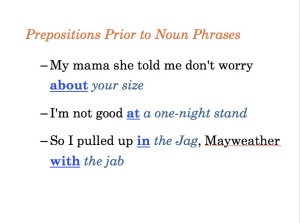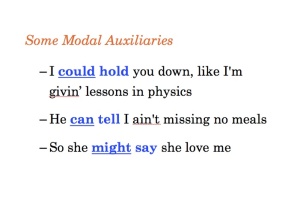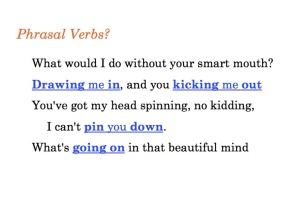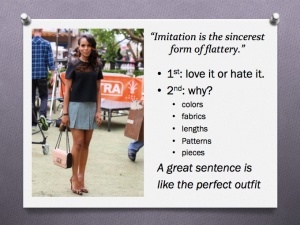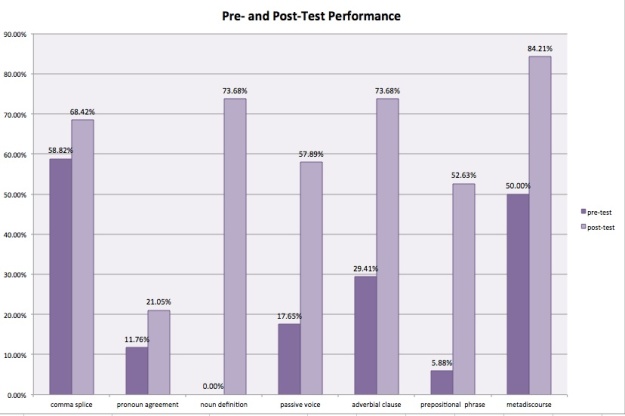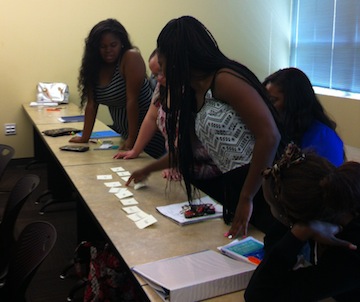We’re to Week 6 of Advanced Grammar and Chapter 5, which focuses on cohesion, in Rhetorical Grammar. Today we examined two grammatical features of cohesive writing, to make sure we meet our readers’ expectations and generally write organized texts.
1. REPETITION
To reinforce the idea of strategic repetition, we read and listened to an excerpt from Martin Luther King Jr.’s 1963 speech. It’s relatively easy to pick out the repeated phrases (“one hundred years later”), but it’s a little less obvious to note King’s use of coordinated nouns modified by increasingly adjective-laden prepositional phrases:
- “the manacles of segregation and the chains of discrimination”
- “a lonely island of poverty in the midst of a vast ocean of material prosperity”
Students observed that the determiner choices in each pair are the same — first “the” and then “a” — and discussed the rhythm of the passage.
2. THE KNOWN-NEW CONTRACT
To wrap up our exploration of “I Have a Dream” and segue into the next activity, we turned to the known-new contract as used by Dr. King with the following example:
Five score years ago, a great American, in whose symbolic shadow we stand signed the Emancipation Proclamation. This momentous decree came as a great beacon light of hope to millions of Negro slaves who had been seared in the flames of withering injustice.
He wraps up one sentence with the Emancipation Proclamation (our new information) and then rewrites it, with the help of a demonstrative pronoun and attention-grabbing modifier, as the known information at the beginning of the next sentence with “this momentous decree.”
The stage thus was set for the Sentence Dating Game!
SENTENCE DATING GAME
Taking my inspiration from the TV game show The Dating Game, I carefully chose pairs of sentences from Their Eyes Were Watching God by Zora Neale Hurston. My goal was to find sets that showed good use of the known-new contract…pairs that clearly were made for each other. Perfect matches, if you will…
- “She left the porch pelting her back with unasked questions. They hoped the answers were cruel and strange.”
- “His coat was over his arm, but he didn’t need it to represent his clothes. The shirt with the silk sleeveholders was dazzling enough for the world.”
- “The idea was funny to them and they wanted to laugh. They tried hard to hold it in, but enough incredulous laughter burst out of their eyes.”
Students were given a sentence strip at random and informed that somewhere in the class was the sentence that came either before or after theirs in Hurston’s novel. Because of this, their first task was to determine what information logically would come both before and after the sentence in their hands. For example, in the first pair above, students might ask if someone had a sentence about questions or answers; in the third pair, the key idea is laughter.
This information formed the basis for the questions they had to ask their classmates. As with The Dating Game, where the eligible singles were hidden from view by a screen, student contestants could not reveal the actual sentences. They only could ask questions designed to elicit recognition (or rejection).
I told the students flat out that this was an untried activity and while I hoped it would be illuminating, I wasn’t sure how long it would take or how hard it would be.
Well, within minutes, students were parading around the classroom arm and arm, declaring they were meant for each other. They joked about love at first sight and fear of commitment. In less than 8 minutes, all sixteen of us (I played, too) had our matches.
The Sentence Dating Game worked, therefore, at least in terms of students being able to perform the desired task in excellent time. Did it reinforce ideas of cohesion and the known-new contract? I hope so.
Here’s a link to a brief description of the known-new contract, along with a practice passage for revision.


